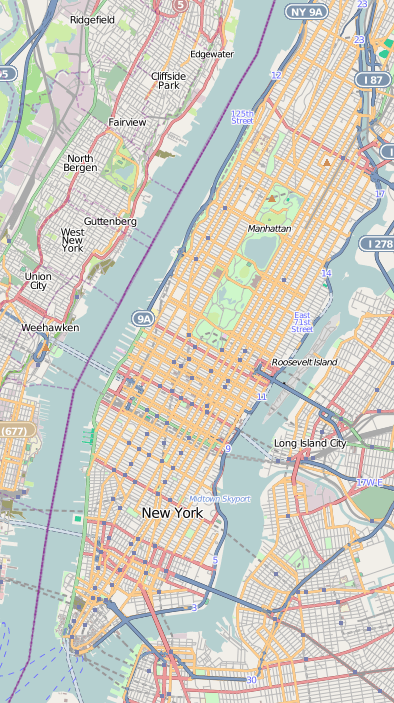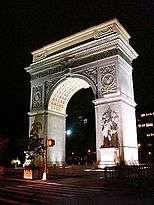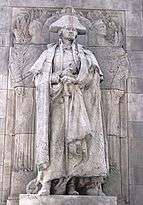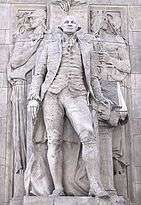Washington Square Arch
The Washington Square Arch is a marble Roman triumphal arch in Washington Square Park, in the Greenwich Village neighborhood of Lower Manhattan, New York City. Begun in 1892, it commemorates the centennial of George Washington's 1789 inauguration as President of the United States, and forms the southern terminus of Fifth Avenue.
The south face of the arch | |
 Location in Manhattan | |
| Coordinates | 40.73099°N 73.99805°W |
|---|---|
| Location | Washington Square, Manhattan, New York City, United States |
| Designer | Architect: Stanford White Sculptors: Frederick MacMonnies (spandrel panels) Philip Martiny (keystone eagles} Hermon A. MacNeil (George Washington As Commander-in Chief Alexander Stirling Calder (George Washington As President) |
| Material | Tuckahoe marble |
| Width | 57 ft (17 m) |
| Height | 73.5 ft (22.4 m) |
| Span | 30 ft (9.1 m) |
Description
Washington Square Arch, constructed of white Tuckahoe marble, was conceived by Stanford White who imitated a Roman Trumphal Arch, iconic monuments Roman Emperors built throughout the empire to celebrate a victory or event. Washington Square Arch stands 77 feet (23 m) high. The piers stand 30 feet (9.1 m) apart and the arch opening is 47 feet (14 m) high. The iconography of the Arch centers on images of war and peace. On the frieze are 13 large stars and 42 small stars interspersed with capital "W"s. The spandrels contain figures of Victory. The inscription on the attic story reads:
Let us raise a standard to which the wise and the honest can repair. The event is in the hand of God.
— Washington
The north side of the eastern pier bears the sculpture George Washington as Commander-in-Chief, Accompanied by Fame and Valor (1914–1916) by Hermon A. MacNeil in which the President is flanked by Fame (left) and Valor (right). The western pier has George Washington as President, Accompanied by Wisdom and Justice (1917–18) by Alexander Stirling Calder (father of Alexander Calder) with flanking Justice (right) and Wisdom (left) figures.[1] In the latter sculpture, a hand holds a book bearing the Latin phrase Exitus Acta Probat ("the end justifies the deed"). These sculptures are commonly referred to as Washington at War and Washington at Peace, respectively. These figures and most of the rest of the carving on the arch was performed by the Piccirilli Brothers.[2]
History
In 1889, a large plaster and wood memorial arch was erected over Fifth Avenue just north of Washington Square Park by local businessman and philanthropist William Rhinelander Stewart (1852–1929). Stewart lived at 17 Washington Square North and his friends contributed $2,765 toward the work. The temporary arch was so popular that three years later the permanent stone arch, designed by architect Stanford White, was erected.[3]
During the excavations for the eastern pier, human remains, a coffin, and a gravestone dated 1803 were uncovered 10 feet (3.0 m) below ground level.[4] The Arch was dedicated in 1895. In 1918, two statues of Washington were added to the north side.
Formerly, the Washington Square Arch was extensively defaced with spray-painted graffiti. It was cleaned and restored in the 1980s.[5]
The arch has often been used as an unofficial symbol of New York University, as the buildings surrounding are owned by the institution.
Gallery
 The north face of the Washington Square Arch
The north face of the Washington Square Arch South face of the Washington Arch at night
South face of the Washington Arch at night George Washington as Commander-in-Chief (1914–1916) by Hermon A. MacNeil
George Washington as Commander-in-Chief (1914–1916) by Hermon A. MacNeil George Washington as President (1917–1918) by Alexander Stirling Calder
George Washington as President (1917–1918) by Alexander Stirling Calder
See also
References
- Washington as President Archived November 8, 2007, at the Wayback Machine from museumplanet.
- Reynolds, Donald Martin, Monuments and Masterpieces: Histories and Views of Public Sculpture in New York City, Macmillan Publishing Company, New York 1988 359–361
- Buescher, John. "Architectural Homage." Teachinghistory.org. Accessed July 12, 2011.
- Geismar, Joan H. (August 2005). "Washington Square Park: Phase 1A Archaeological Assessment" (PDF). New York City Department of Parks and Recreation. p. 24 (PDF p. 30). Archived from the original (PDF) on July 3, 2007. Retrieved October 1, 2007.
- Ralph Gardner (March 8, 2011). "Inside the Washington Arch". The Wall Street Journal. Retrieved January 8, 2015.
External links

- Guide to the Records of the Washington Arch, 1872–1925